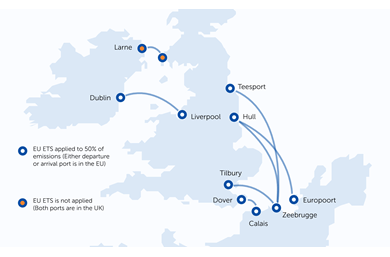EU ETS
Emission Trading Scheme
What is EU ETS?
EU Emission Trading Scheme (ETS) has been initiated to combat climate change by reducing greenhouse gas emissions. EU ETS is part of the EU's Fit for 55 plan to reduce greenhouse gas emissions to 55% of 1990 levels by 2030 and for the EU to be carbon neutral by 2050. The aim of EU ETS is to price out fossil fuels and price in alternative fuels and increased investments in efficiency. Details on the EU ETS can be found here.
The price of an EU ETS allowances (EUA) fluctuates according to market supply and demand. For September 2023 the price was EUR 85 per ton of CO2 (Carbon Price Viewer).
How does EU ETS apply to shipping?
The UN Framework Convention on Climate Change and negotiations sessions held as annual conferences of Parties (COPs) push forward the global conversation on climate change and actions required to address it. Shipping is essential to global supply chains and a significant contributor of carbon emissions representing approximately 3% of annual total human generated carbon releases.
Starting in 2024, EU ETS will cover commercial ships above 5000 gross tonnage that are transporting cargo or passengers, calling at any EU port (regardless of the flag the ships fly). From 1st January 2024 operators of vessels including ferries will start paying for emissions generated on route to and from EU ports.
ETS applies to 100% of emissions from voyages within the EU, 50% of emissions from voyages starting or ending outside of the EU, and 100% emissions when ships are at berth in EU ports (excluding non-commercial movements, e.g. dry dock).

To allow for a smooth transition to EU ETS, shipping companies will adopt the requirements during a three year phase-in during which EUAs will be purchased and surrendered for a portion of total applicable emissions: 40% in 2024, 70% in 2025 and 100% in 2026.

Further Reading - FAQ – Maritime transport in EU Emissions Trading System (ETS) (europa.eu) and Reducing emissions shipping sector (europa.eu).
What does it mean to our customers?
From 1st January 2024 all shipping companies operating within the EU (fully and partially) will need to purchase EUAs. The EU ETS will have an impact on the industry’s cost, with further market impact on supply chains that are dependent on maritime transport, or by other means such as aviation.
From 1st January 2024 P&O Ferries will introduce an EU ETS surcharge for our routes operating within the EU (see map). Some EU ETS applicability and administrative details are still being clarified by the EU. As the shipping commencement date approaches, further details will be provided by the EU and we will inform our customers of implications - to ensure you are kept fully informed we will issue customer updates on a regular basis on our website and also directly to our customer account managers.
Preliminary ETS surcharges to be added from January 2024 will be published during the autumn, with costs in applicable currencies per journey according to unit type.
The fuel surcharge for routes with at least one EU port will be updated monthly based on market average prices for CO2 emissions, and with currency conversion rates also fixed on a monthly basis. Updates to the applicable rates will be published on the first day of each month.
P&O Ferries approach to sustainability
P&O Ferries is committed to sustainability across our operations with programmes to transition our fleet to new fuels as well as enhance vessel operation efficiency, and make changes onshore to reduce our impact in ports, offices and the rest of our business.
For our fleet, as we progress on our journey to more sustainable fuel types and work to reduce our carbon emissions, we are introducing two revolutionary hybrid vessels on the Dover-Calais route. As our carbon emissions fall, our customers will also see the carbon impact of their operations reduce.
We are committed to playing our part in achieving national and international net zero goals, and to supporting the ambitious targets of our parent company DP World. To read more about DP World Sustainability strategy – click here.
UK ETS
The UK plans to include maritime within the existing UK ETS from 2026, which is expected to affect domestic shipping routes. We will continue to monitor the implications for our customers and our business, providing updates accordingly.
